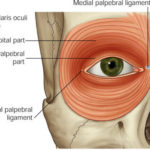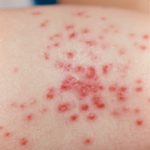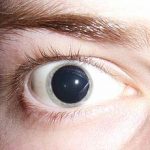Scalp Folliculitis
What is Scalp Folliculitis?
Scalp Folliculitis is a condition that affects hair follicles on the scalp leading to an inflammation. The outcome is formation of red bumps on the scalp that can be very itchy and painful if scratched.
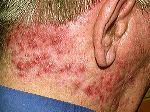
Scalp Folliculitis often causes hair loss on the area affected leaving bald patches meaning that there will be no more hair growth. In severe cases, the condition is referred to as “acne necrotica miliaris” or “proprionibacterium folliculitis” whereby the pimples formed on the scalp are larger in size and crusty leading to permanent scars and the scalp appears as shown below:
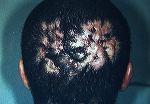
It is in rare situations that this advanced stage (proprionibacterium folliculitis) occurs and it is very difficult to treat. Black adult men are the most victims when it develops and is not common among the whites.2
Causes
Though the origin of Scalp Folliculitis is not properly known, it is often associated with microorganisms, which invade and affect the hair follicles which are:
- Bacteria
- Yeast
- Mite
Accumulation of these micro-organisms that eventually lead to the development of folliculitis on the scalp could be due to:
- The prolonged use of hair products such as shampoo, oil and other chemical treatments. These can be unfriendly to the delicate skin of your scalp and have a high probability of irritating the hair follicles.
- Swimming in a pool that has not been treated or bathing in a hot tub that may contain accumulated dirt. These facilities should be cleansed and treated on a regular basis to clear off any germs present.
- If you have an open wound or cut on the head, however small it might look, it acts as a starting point for the folliculitis formation
- Some diseases such as HIV where the victims body lacks the immunity required towards infections.
Symptoms
An individual with scalp folliculitis may exhibit the following symptoms and signs:
- Small red pimple on the scalp
- Itchiness and constant scratching
- Hair loss, especially along the hair line
- Sometimes the pimples may be many and have crusts on them.
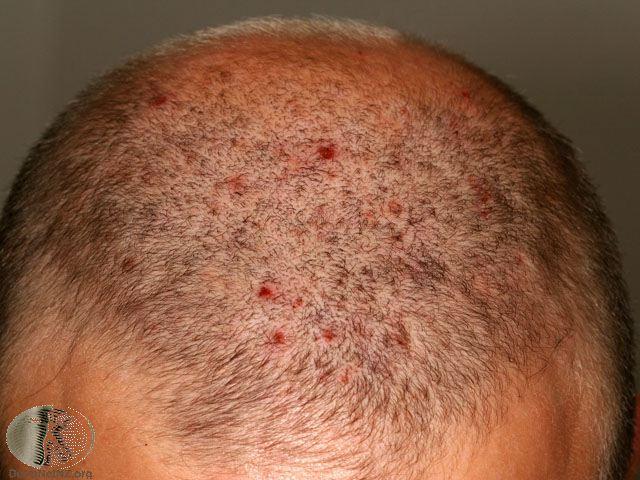
Treatment & Management
To manage and prevent recurrence of Scalp Folliculitis, you may prefer using antibiotics or just handling the situation at home. Antibiotic medications can be prescribed to counter bacterial infections.
However, the staphylococcus bacteria, which are the most dominant in folliculitis, can sometimes be resistant to antibiotics and hence may require stronger medications.
These antibiotics can either be in the form of oral tablets or syrup, creams or lotion and may include;
- Tetracycline
- Fusidic acid gel
- Erythromycin solution
- Antihistamines
- Steroid creams
- Isotretinoin
Different antibiotics may be prescribed for a long or short term basis depending on the severity of the disease. It is recommended to conduct a test before any prescription in order for the dermatologist to determine the best medication for you.
Home Remedies
It is possible also to treat Scalp Folliculitis at home either by using antibacterial soap or anti-fungal shampoos to wash you scalp or through other remedies such as:
Hot compress
You can prepare a salt or vinegar solution by adding a table spoon of either into one cup of hot water. A piece of towel can then be dipped into the solution and used to massage the affected areas on the scalp to relieve the itchiness.
This can be repeated on a daily routine until you are sure that the discomfort has cooled down.
Aloe Vera
This plant is known for the antibacterial benefits found in its juice. Squeeze the juice out of an aloe vera leaf and directly apply it to the affected area to help rest the itchy feeling and heal any open wound on the scalp.
The gel can rest on for a period of 15-20 minutes then rinsed off. Daily application can give effective results.
Tea tree oil
This can be used as an antiseptic to treat inflammations, and clear any fungal, bacterial or viral infections. On a daily routine, use this oil by applying a few drops to your scalp to soothe the itchiness and reduce inflammations.
Castor oil
Just like tea tree oil, castor can be used to alleviate pain and the inflamed pimples. The oil can be applied daily to the scalp for effective results.
Coconut oil
Pure coconut oil has antibacterial and anti-oxidant properties. Using it on your scalp daily can speed up the healing process of the affected hair follicles and any other infection present on your scalp.
Cucumber
Make a paste of ground or grated cucumber and smear it on the affected area. This way, the pain will cool down and the pimples may be dissolved leaving a comfortable feeling on your scalp. Always purchase and use them regularly for better results.
Garlic
Apart from being a vegetable or rather an ingredient in the kitchen, garlic can be used for medicinal purposes in different ways.
In this case, you can crash the cloves to extract its juice and use it to treat inflammations on your scalp. The juice contains an acid that kills bacteria and relieves any inflammation.
Vinegar
A solution of vinegar can have a soothing effect, especially on the inflammation and irritation. Small amounts of vinegar can be mixed with hot water and then directly applied to the scalp 2-3 times a day for better results as it helps kill all microorganisms causing bacteria.
Turmeric
You can choose to use turmeric powder or the unprocessed turmeric itself. If you are using powder, apply it directly to the bumps on your scalp.
Raw turmeric must be ground into a smooth paste then smeared on the affected area of the scalp and left to rest for a while so that the curcumin in it can help alleviate the pain and heal the inflamed parts.
Neem
The neem tree has been long known for its medicinal value and has been used for various diseases, especially those associated with bacteria and fungus infection including ringworms and dandruffs.
An antibacterial solution can be prepared at home by picking and boiling a good number of neem leaves in at least two liters of water. The solution can then be used when washing your scalp and it should be on a regular basis until the problem goes away.
Draining
This is done to empty pus from the swollen bumps. This therefore requires a physician who will use sterilized gauze to drain the pus by making an incision in the pimple to prevent further infection.
In addition to the above remedies, it is advisable to keep combs and other hair materials clean after using them. Those with a habit of sharing towels, hats, scarves and shaving blades should realize the risk they are putting themselves into and start handling personal items carefully.
In case folliculitis is suspected, it recommended to visit a dermatologist or a physician to help curb the spread of the infection since it can become difficult to handle in severe stages.
Pictures
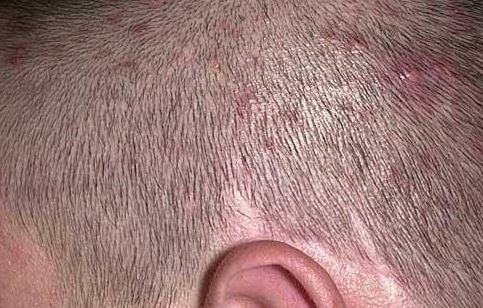
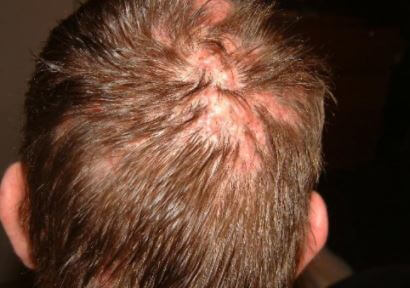
Reference List
- Scalp Folliculitis: Causes, Symptoms And Treatment. Available at
- http://www.doctorshealthpress.com/general-health-articles/scalp-folliculitis
- Scalp Folliculitis. Available at
- http://www.dermnetnz.org/topics/scalp-folliculitis/
- What are the treatments for folliculitis on the scalp? Available at
- http://www.livestrong.com/article/202678-what-are-the-treatments-for-folliculitis-on-the-scalp/
- How to Remedy Inflamed Hair Follicles. Available at
- http://www.livestrong.com/article/206315-how-to-remedy-inflamed-hair-follicles/


